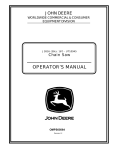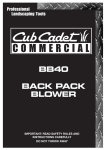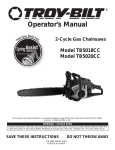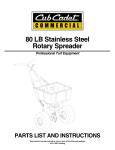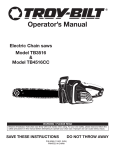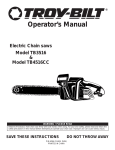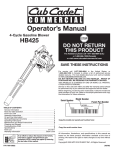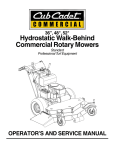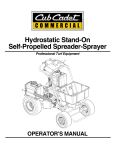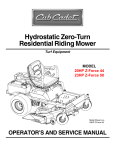Download Cub Cadet CS5220 Specifications
Transcript
Professional Landscaping Tools CS5018 / CS5220 18 or 20” CHAIN SAW IMPORTANT: READ SAFETY RULES AND INSTRUCTIONS CAREFULLY DO NOT THROW AWAY Table of Contents Content Page Introduction . . . . . . . . . . . . . . . . . . . . . . . . . . . . . . . . . . . . . . . . . . . . . . . . . . . . . . . . . . . . . . . 2 Safety . . . . . . . . . . . . . . . . . . . . . . . . . . . . . . . . . . . . . . . . . . . . . . . . . . . . . . . . . . . . . . . . . . . 3 Know Your Unit . . . . . . . . . . . . . . . . . . . . . . . . . . . . . . . . . . . . . . . . . . . . . . . . . . . . . . . . . . . . 7 Fitting the Bar & Chain . . . . . . . . . . . . . . . . . . . . . . . . . . . . . . . . . . . . . . . . . . . . . . . . . . . . . . . 8 Oil & Fuel . . . . . . . . . . . . . . . . . . . . . . . . . . . . . . . . . . . . . . . . . . . . . . . . . . . . . . . . . . . . . . . . 10 Operation . . . . . . . . . . . . . . . . . . . . . . . . . . . . . . . . . . . . . . . . . . . . . . . . . . . . . . . . . . . . . . . . 11 Carburetor Adjustment . . . . . . . . . . . . . . . . . . . . . . . . . . . . . . . . . . . . . . . . . . . . . . . . . . . . . 13 Kickback. . . . . . . . . . . . . . . . . . . . . . . . . . . . . . . . . . . . . . . . . . . . . . . . . . . . . . . . . . . . . . . . . 14 Chain Brake . . . . . . . . . . . . . . . . . . . . . . . . . . . . . . . . . . . . . . . . . . . . . . . . . . . . . . . . . . . . . . 15 Cutting Techniques . . . . . . . . . . . . . . . . . . . . . . . . . . . . . . . . . . . . . . . . . . . . . . . . . . . . . . . . 16 Maintenance. . . . . . . . . . . . . . . . . . . . . . . . . . . . . . . . . . . . . . . . . . . . . . . . . . . . . . . . . . . . . . 18 Specifications . . . . . . . . . . . . . . . . . . . . . . . . . . . . . . . . . . . . . . . . . . . . . . . . . . . . . . . . . . . . 22 Warranty . . . . . . . . . . . . . . . . . . . . . . . . . . . . . . . . . . . . . . . . . . . . . . . . . . . . . . . . . . . . . . . . . 24 To the Operator Thank you for buying this quality product. This modern outdoor power tool will provide many hours of useful service. You will find it to be a great labor-saving device. This operator’s manual provides you with easy-to-understand operating instructions. Before starting or operating this equipment, read the whole manual and follow all the instructions to keep your new outdoor power tool in top operating condition. All information, illustrations and specifications in this manual are based on the latest product information available at the time of printing. We reserve the right to make changes at any time without notice. Service on this unit both within and after the warranty period should be performed only by a Cub Cadet Commercial dealer. Proof of purchase will be required for warranty service. Spark Arrestor NOTE: For users on U.S. Forest Land and in the states of California, Maine, Oregon and Washington. All U.S. Forest Land and the state of California (Public Resources Codes 4442 and 4443), Oregon and Washington require, by law that certain internal combustion engines operated on forest brush and/or grass-covered areas be equipped with a spark arrestor, maintained in effective working order, or the engine be constructed, equipped and maintained for the prevention of fire. Check with your state or local authorities for regulations pertaining to these requirements. Failure to follow these requirements could subject you to liability or a fine. This unit is factory equipped with a spark arrestor. If it requires replacement, Spark Arrestor Screen is available by contacting the service department. Calling Customer Support If you have difficulty assembling this product or have any questions regarding the controls, operation or maintenance of this unit, please call the Customer Support Department. Call 1-877-282-8684 to reach a Customer Support representative. Please have your unit’s model number and serial number ready when you call. See the previous section to locate this information. Copyright© 2003 Cub Cadet Commercial LLC All Rights Reserved For more details about your unit, visit our website at www.cubcadetcommercial.com 2 Section 1 Safety The purpose of safety symbols is to attract your attention to possible dangers. The safety symbols, and their explanations, deserve your careful attention and understanding. The safety warnings do not by themselves eliminate any danger. The instructions or warnings they give are not substitutes for proper accident prevention measures. SYMBOL MEANING SAFETY ALERT SYMBOL: Indicates danger, warning or caution. Attention is required in order to avoid serious personal injury. May be used in conjunction with other symbols or pictographs. NOTE: Advises you of information or instructions vital to the operation or maintenance of the equipment. Failure to obey a safety warning will result in serious injury to yourself or to others. Always follow the safety precautions to reduce the risk of fire, electric shock, and personal injury. Failure to obey a safety warning can result in injury to yourself and others. Always follow the safety precautions to reduce the risk of fire, electric shock, and personal injury. California Proposition 65 Warning THE ENGINE EXHAUST FROM THIS PRODUCT CONTAINS CHEMICALS KNOWN TO THE STATE OF CALIFORNIA TO CAUSE CANCER, BIRTH DEFECTS OR OTHER REPRODUCTIVE HARM. Failure to obey a safety warning may result in property damage or personal injury to yourself or to others. Always follow the safety precautions to reduce the risk of fire, electric shock, and personal injury. Important Safety Information READ ALL INSTRUCTIONS Before Operating If correctly used, the chain saw is a quick, easy to handle and efficient tool; if used improperly or without the due precautions it could become a dangerous tool. For pleasant and safe work,always strictly comply with the safety rules that follow and throughout this manual. • Read the instructions carefully. Be familiar with the controls and proper use of the unit. • Do not operate this unit when tired, ill or under the influence of alcohol, drugs or medication. • Only responsible individuals who are familiar with the instructions may operate the chain saw (no one under the age of 16). Provide parental supervision at all times. • Inspect the unit before use. Replace damaged parts. Check for fuel leaks. Make sure all fasteners are in place and secure. Replace parts that are cracked, chipped or damaged in any way. • Know the controls and know how to stop the chain saw quickly. • Carry the chain saw with the engine stopped, the guide bar and saw chain to the rear, and the muffler away from your body. • When transporting your chain saw, use the appropriate guide-bar scabbard (sheath). While Operating • Keep all parts of your body away from the chain when the engine is running. • Never start or run the unit inside a closed room or building. Breathing exhaust fumes can kill. Operate this unit only in a well ventilated outdoor area. • Wear safety glasses or goggles that are marked as meeting ANSI Z87.1-1989 standards. Also wear ear/hearing protection when operating this unit. Wear a face or dust mask if the operation is dusty. Long sleeve shirts are recommended. • Wear heavy, long pants, boots or safety footwear and protective gloves. Do not wear loose clothing, jewelry, short pants, sandals or go barefoot. Secure hair above shoulder level. • Use the unit only in daylight or good artificial light. 3 Safety (continued) • Avoid accidental starting. Be in the starting position whenever pulling the starter rope. The operator and unit must be in a stable position while starting. See Starting/Stopping Instructions. Kickback Safety Precautions • Before you start the engine, make sure that the saw’s chain is not contacting anything. Do not cut near electrical cables or power lines. KICKBACK may occur when the nose or tip of the guide bar touches an object, or when the wood closes in and pinches the saw chain in the cut. Tip contact in some cases may cause a lightning-fast reverse reaction, kicking the guide bar up and back towards the operator. Pinching the saw chain along the top of the guide bar may push the guide bar rapidly back toward the operator. Either of these reactions may cause you to lose control of the saw, which could result in serious personal injury. • Keep all parts of your body away from the chain when the engine is running. • Do not start cutting until you have a clear work area, secure footing, and a planned retreat path from the falling tree. • Do not operate a chain saw that is damaged, improperly adjusted, or not completely and securely assembled. Be sure that the saw’s chain stops moving when the throttle control trigger is released. • Shut off the engine before setting the chain saw down. • Use extreme caution when cutting small-sized brush and saplings because slender material may catch the chain saw and whip towards you or pull you off balance. • When cutting a limb that is under tension, be alert for springback so that you will not be struck when the tension in the wood fibers is released • Do not cut through nails, rods in the tree, railroad ties or pallates. Inspect a tree that you are going to cut for foreign objects that could cause injury or damage to your chain saw. • After striking a foreign object, stop the engine and thoroughly inspect for damage. Repair as necessary. • Keep the handles dry, clean and free of the oil/fuel mixture • We do not recommend using the chain saw in a tree or on a ladder. • All chain saw service, other that the items listed in this instruction manual maintenance instructions, should be performed by competent chain saw service personnel. • Use the right tool. Only use this chain saw for its intended purpose, to cut wood. • Do not overreach. Always keep proper footing and balance. • Always hold the unit with both hands when operating. Keep a firm grip on all handles or grips. • Apply chain brake prior to any repositioning of the operator in the cutting area. As an additional safety precaution, apply the chain brake prior to setting down the saw. • Never touch the chain or attempt to service the saw while the engine is running. Make sure all moving parts have stopped. Allow the chain saw to cool, as the chain can be hot. • Check the bar and chain at frequent intervals for proper adjustment. Make sure the bar and chain are properly tightened and sharpened. Visually inspect for damage. Repair any damage before restarting or operating the chain saw. 4 Do not rely exclusively upon the safety devices built into your saw. As a chain saw user, you should take several steps to keep your cutting jobs free from accident or injury. • With a basic understanding of kickback, you can reduce or eliminate the element of surprise. Sudden surprise contributes to accidents. Be alert to the potential for kickback at all times. • Keep a good firm grip on the saw with both hands, the right hand on the rear handle and the left hand on the front handle, when the engine is running. Use a firm grip with thumbs and fingers encircling the chain saw handles. A firm grip will help you reduce kickback and maintain control of the saw. Don’t let go. • Make sure that the area in which you are cutting is free from obstructions. Do not let the nose of the guide bar contact a log, branch, fence, or any other obstruction that could be hit while you are operating the saw. • Always cut with the engine running at full speed. Fully squeeze the throttle trigger and maintain a steady cutting speed. • Use only the correct original equipment manufacturer replacement bars, chains and other parts and accessories. These are available from your authorized service dealer. Use of any unauthorized parts or accessories could lead to serious injury to the user, or damage to the unit, and will void your warranty. • Follow the manufacturer’s sharpening and maintenance instructions for the saw chain. • Use only the replacement guide bars and low kickback chains specified for your saw to avoid injury. Other Safety Precautions • Do not operate a chain saw with one hand! Serious injury to the operator, helpers, bystanders, or any combination of these persons may result from onehanded operation. A chain saw is intended for twohanded use. • Do not operate a chain saw if you are fatigued. • Use safety footwear; snug-fitted clothing; protective gloves; and eye, hearing, and head protection devices. Safety (continued) • Use caution when handling fuel. Move the chain saw at lest 10 feet (3 m) from the fueling point before starting the engine. • Store the unit in a dry area, locked up, located up high and located out of the reach of children to prevent unauthorized use or damage. • Do not allow other persons to be near the chain saw when starting or cutting with the chain saw. Keep bystanders and animals out of the work area. • Never douse or squirt the unit with water or any other liquid. Keep handles dry, clean and free from debris. Clean after each use. • Do not remove, damage or de-activate any of the safety devices. Never use a damaged, modified, or improperly repaired or assembled chain saw. Check their proper operation regularly. Only use bars and chains of the length indicated in the table herein. • Keep these instructions. Refer to them often and use them to instruct other users. If you loan someone this unit, also loan them these instructions. • Never carry out operations or repairs on your own that are other than routine maintenance. For information, contact specialized and authorized workshops only. • If your chain saw is no longer usable, dispose of it properly without damaging the environment by handing it in to your local dealer who will arrange for its correct disposal. • Do not use the unit in the rain, in a storm or in inclement weather. Wait until the storm danger has passed before operation of this product. Gasoline is highly flammable, and its vapors can explode if ignited. Take the following precautions. • Use caution when felling a tree. Make sure you have planned an escape path when felling, and keep all bystanders away. Fuel Safety • Be alert; stop the machine if anyone enters the cutting area, which is usually 3 to 4 feet around the operator. • Store fuel only in containers specifically designed and approved for the storage of such materials. • Use caution when working in a crew to avoid injury to a fellow worker who may enter the cutting area. • Always stop the engine and allow it to cool before filling the fuel tank. Never remove the cap of the fuel tank, or add fuel, when the engine is hot. Never operate the unit without the fuel cap securely in place. Loosen the fuel tank cap slowly to relieve any pressure in the tank. • Only loan your saw to experienced users who are completely familiar with saw operation and correct use. Give other users this manual, which they should read before using the saw. Provide them the operating instructions. • Shut off the engine before setting down the saw. Do not leave the engine running unattended. • Never store the unit, with fuel in the tank, inside a building where fumes may reach an open flame or spark. • Allow the engine to cool before storing or transporting the chain saw over long distances. For example, let the engine cool before placing the chain saw in an automobile. Also, be sure to secure the unit while transporting. • Add fuel in a clean, well-ventilated outdoor area where there are no sparks or flames. Slowly remove the fuel cap only after stopping engine. Do not smoke while fueling or mixing fuel. Wipe up any spilled fuel from the unit immediately. • Avoid creating a source of ignition for spilled fuel. Do not start the engine until fuel vapors dissipate. • Move the unit at least 30 feet (9.1 m) from the fueling source and site before starting the engine. Do not smoke. Keep sparks and open flames away from the area while adding fuel or operating the unit. SAVE THESE INSTRUCTIONS 5 Safety (continued) Safety and International Symbols This operator's manual describes safety and international symbols and pictographs that may appear on this product. Read the operator's manual for complete safety, assembly, operating and maintenance and repair information. SYMBOL MEANING • SAFETY ALERT SYMBOL Indicates danger, warning, or caution. May be used in conjunction with other symbols or pictographs. SYMBOL MEANING • ON/OFF STOP CONTROL ON / START / RUN • ON/OFF STOP CONTROL • WARNING - READ OPERATOR'S MANUAL Read the Operator’s Manual(s) and follow all warnings and safety instructions. Failure to do so can result in serious injury to the operator and/or bystanders. • WEAR EYE, HEARING AND HARDHAT PROTECTION WARNING: Thrown objects and loud noise can cause severe eye injury and hearing loss. Wear eye protection meeting ANSI Z87.1-1989 standards and ear protection when operating this unit. Wear a hard hat. Use a full face shield when needed. • UNLEADED FUEL Always use clean, fresh unleaded fuel. • OIL Refer to operator's manual for the proper type of oil. 6 OFF OR STOP • HOT SURFACE WARNING Do not touch a hot muffler or cylinder. You may get burned. These parts get extremely hot from operation. When turned off they remain hot for a short time. • GUIDE BAR WARNING: Contact of the guide bar tip with any object should be avoided. Tip contact may cause the guide bar to move suddenly upward and backward, which may cause serious injury. • USE BOTH HANDS Always use both hands while operating the chain saw. Never use only one hand to operate the saw. Section 2 Know Your Unit Chain Saw Components 1 - Choke lever 2 - Throttle trigger 3 - Throttle trigger lockout 4 - Carburetor adjustment screws 5 - Inertial brake lever 6 - Exhaust muffler 7 - Chain 8 - Guide bar 9 - Air filter cover 10 - On/off switch 11 - Fuel tank cap 12 - Starter handle 13 - Oil tank cap 14 - Primer bulb 15 - Decompression valve 16 - Lateral chain tensioner screw 7 Section 3 Fitting the Bar & Chain 1 Check the chain tension frequently when operating the chain saw. Always use protective gloves. With the engine off, follow the ensuing instructions: • Pull the guard (Fig. 1) towards the front handle to check that the chain brake is not on. • Remove the bar nuts (A) and the chain cover (B, Fig. 2). • Remove and discard the plastic shim from the bar studs (C, Fig. 3). • Take the chain tightener pawl (D, Fig. 3) to the limit stop, by unscrewing all the chain tightener screw (L). • Place the bar (F, Fig. 3) onto the studs (N). • Fit the chain (H, Fig. 4) inside the sprocket (E) and the bar groove (M). 2 3 4 8 NOTE: Pay attention to the direction of rotation of the chain (Fig. 6). Fitting the Bar & Chain (continued) 5 • Put down the chain cover, inserting it into its housing and, keeping it pressed against the bar, screw on the chain tightener screw (L, Fig. 5) so that the pawl (D, Fig. 3) goes into the hole (G, Fig. 3) of the bar. • Fit the chain cover and the relative nuts without tightening them. • Tension the chain by means of the tensioning screw (L, Fig. 5). • Hold the tip of the guide bar up and tighten the chain cover nuts securely (Fig. 7). The chain should be taut but turn freely by hand (Fig. 8). • The chain is tensioned correctly when it can be pulled upwards a few millimeters (Fig. 8). 6 7 8 9 Section 4 Oil and Fuel FUEL MIXTURE 9 Refer to the values in Figure 9. Use a 2% (50:1) oil/gasoline mixture. + UNLEADED GAS 2 CYCLE OIL (2%) 1 GALLON US (3.8 LITERS) 2.56 FL. OZ. (76 ml) 1 LITER 20 ml MIXING RATIO - 50:1 10 Two-stroke engines have high specific horsepower and we therefore recommend the use of wellknown, super gasoline, without lead and an octane rating of no less than 90. When preparing the mixture, only use a high quality oil designed for aircooled two stroke engines. Shake the fuel canister before filling. Refill (Fig. 10) when the engine is switched off and far away from an open flame. Before unscrewing the fuel tank cap, position the chain saw on a flat, solid surface to prevent fuel spills. Only prepare the quantity of mixture for each job, do not leave the mixture in the fuel tank or in a fuel canister for prolonged periods. CHAIN LUBRICATING OIL 11 Proper chain lubrication during the cutting phase will reduces wear to a minimum between the chain and bar. Correctly lubricating the chain will prolonging the chain saw’s life. Always use a good quality oil (Fig. 11). Refill the oil reservoir each time you refill the unit with fuel. Never use waste oil. Always use biodegradable lubricant (part number em-1108014) which is specific for bar and chain and also respectful towards nature and the chain saw's parts. 10 Section 5 Operation 12A 12B STARTING THE ENGINE 1. Fill the carburetor by pushing primer bulb (A, Fig. 12B). 2. Put the ON/OFF switch (C, Fig. 12A) in the START position. 3. Pressing the push button (E, Fig. 14) opens the decompression valve. It will automatically close at the first start. We suggest to press the push button before every start. 4. Pull the choke lever (D, Fig. 12B). 13 5. Place the chain saw on the ground in a stable position. Check that the chain is free to turn and will not come into contact with any foreign objects. 6. Hold the front handle firmly with your left hand and put your right foot onto the base of the rear handle (Fig. 13). Pull the starter rope slowly until you meet resistance, then pull it hard several times 7. When the engine starts, put the choke lever (D, Fig. 12B) back into its initial position. Repeat this until the engine starts. 14 8. Once the engine has started, release the chain brake and wait for a few seconds. Then accelerate with the throttle (B, Fig. 12) to fire the half throttle-blocking device. NOTE: Once the engine is warmed up, do not use the choke to start up again. Use the half-throttle lever and other partial acceleration devices only when you are initially starting the engine. Operate this unit only in a well-ventilated outdoor area. Carbon monoxide exhaust fumes can be lethal in a confined area. BREAKING-IN THE ENGINE The engine break-in period is approximately 20 hours. During this period, avoid prolonged high-speed full throttle operation. Avoid accidental starting. Make sure you are in the starting position when pulling the starter rope (Fig. 13). To avoid serious injury, the operator and unit must be in a stable position while starting. 11 Operation (continued) 15 STOPPING THE ENGINE Release the throttle lever and let the engine return to idle. (B, Fig. 15). Turn off the engine, putting the ON/OFF switch (C) in the STOP position. Do not put the chain saw on the ground when the chain is still moving. BREAKING-IN THE CHAIN 16 New chains will stretch and must be tightened frequently. Tension adjustment must only be made when the chain is cool. 1. Turn the chain and lubricate it with additional oil (Fig. 16). 2. Start the saw and allow it to run at moderate speed. Check to make sure that the oil pump is working properly (Fig. 17). 3. Stop the engine and adjust the chain tension. 4. Start the saw again and make a few cuts in the trunk of a tree to heat up the chain. 5. Stop the engine and allow the chain to cool and adjust again. 17 6. Repeat this process until the chain retains proper tension. Do not touch the ground with the chain during this process. Never touch or adjust the chain while the engine is running. 12 Section 6 Carburetor Adjustment 18 CARBURETOR 19 Before adjusting the carburetor, clean the starter cover (Fig. 18), the air filter (Fig. 19) and warm up the engine. This engine is designed and manufactured in order to comply with the applicable Exhaust Emission Standards. The Exhaust Emission Control System includes the ignition system, the air inlet system and, mainly, the carburetor. In this engine, the carburetor (Fig. 20) is designed to permit only the adjustment of L and H screws in a range of half a round; the half round range admissible for L and H screws is determined by the manufacturer and you cannot modify it. Don’t try to force the screws outside the range! • Idle screw T is adjusted in order to ensure a good safety margin between idle running and clutch engagement. • Screw L must be adjusted so that the engine promptly responds to sharp accelerations and gives good idle operation. 20 • Screw H must be adjusted so that the engine gives maximum power during the cutting phase. Weather conditions and altitude may affect carburetor performance. H – High speed adjustment screw L – Low speed needle T – Idle adjustment screw 20A Do not allow anyone to stay close to the chain saw while working or while adjusting the carburetor. 20B COLD WEATHER DEVICE In the event of temperatures below 0°C, move the cursor (A, Fig. 20A) to the winter position. The winter symbol (Fig. 20A) should remain on the right, not covered by the gasket. This allows heated air from the cylinder to enter, preventing formation of ice inside the carburetor. When the temperature is above 10°C, move the cursor (A, Fig. 20B) to the summer position. NOTE: Failure to reset this parameter could impair motor performance due to overheating. 13 Section 7 Kickback 21 PRECAUTIONS AGAINST KICKBACK Kickback is a dangerous reaction that can lead to serious injury. Do not rely only on the safety devices provided with your saw. As a chain saw user, you must take special safety precautions to help keep your cutting jobs free from accident or injury. KICKBACK WARNINGS Refer to Figures 21, 22, 23. 22 23 KICKBACK occurs when the moving chain contacts an object at the upper portion of the tip of the guide bar or when the wood closes in and pinches the saw chain in the cut. Contact at the upper portion of the tip of the guide bar can cause the chain to dig into the object and stop the chain for an instant. The result is a lightning fast, reverse reaction which kicks the guide bar up and back toward the operator. If the saw chain is pinched along the top of the guide bar, the guide bar can be driven rapidly back toward the operator. Either of these reactions can cause loss of saw control which can result in serious injury. Do not rely exclusively upon the safety devices built into your saw. As a chain saw user, you should take several steps to keep your cutting jobs free from accident or injury. • With a basic understanding of kickback, you can reduce or eliminate the element of surprise. Sudden surprise contributes to accidents. 24 • Keep a good firm grip on the saw with both hands when the engine is running. Place your right hand on the rear handle and the left hand on the front handle with your thumbs and fingers encircling the chain saw handles. A firm grip together with a stiff left arm will help you reduce kickback and maintain control of the saw. • Make sure that the area in which you are cutting is free from obstructions. Do not let the nose of the guide bar contact a log, branch, fence, or any other obstruction that could be hit while you are operating the saw. • Always cut with the engine running at full speed. Fully squeeze the throttle trigger and maintain a steady cutting speed. LOW KICKBACK SAW CHAIN The rakers (depth gauges) (Fig. 24) ahead of each cutter can minimize the force of a kickback reaction by preventing the cutters from digging in too deeply at the kickback zone. Only use replacement chain that is equivalent to original chain or has been certified as low kickback chain per ANSI B175.1 for your saw. Low kickback saw chain is chain that has met the kickback performance requirements of ANSI B175.1 1991 (American National Standard for Power Tools Gasoline-Powered Chain Saws-Safety Requirements) when tested on the representative sample of chain saws below 3.8 c.i.d. specified in ANSI B175.1 - 1991. 14 • Follow the sharpening and maintenance instructions for the saw chain. • Use only the replacement guide bars and low kickback chains specified for your saw. GUIDE BARS Generally, guide bars with small radius tips have somewhat lower kickback potentials. The manufacturer’s gasoline saws meet the kickbackreduction requirements of ANSI B175.1 without requiring small radius tip bars. Kickback (continued) RECOMMENDED BAR & CHAIN COMBINATIONS Chains .325”x.058” Model Bar length Bar description Chain description CS5018 18” .325 490-700-0004 490-700-0008 CS5220 20” .325 490-700-0005 490-700-0009 Section 8 Chain Brake 25 INERTIAL CHAIN BRAKE 26 The inertial chain brake ensures maximum safety when using the chain saw. It protects the operator from dangerous kickback which can occur during working phases. The chain brake can be actuated in two ways. First, when the operator presses the lever (Fig. 25) (manual operation) the chain consequently and instantly locks. The chain brake is also actuated automatically. This occurs by inertia, when the protective brake is pushed forward (Fig. 26) due to sudden kickback (inertial operation). The chain brake is released by pulling the lever towards the operator (Fig. 27). CHECKING BRAKE OPERATION 27 When you inspect the machine before each job, check the operating condition of the brake following the steps: 1. Start the engine and grasp the handle securely with both hands. 2. Pull the throttle lever to maintain the chain operation, push the brake lever down toward the front using the back of your left hand (Fig. 25). 3. When the brake operates and the chain is stopped, release the throttle lever. 4. Release the brake (Fig. 27). BRAKE MAINTENANCE Always keep the chain brake mechanism clean and lubricate the lever with a small amount of oil (Fig. 28). Check wear on the brake band often. Its minimum thickness must be 0.60 mm (0.02”). 28 Do not use any non-comforming components. Do not remove any saw chain safety devices. 15 Section 9 Cutting Techniques (Felling, Limbing Bucking) 29 31 30 32 OPERATING INSTRUCTIONS Always follow the safety precautions. The chain saw must only be used for cutting wood. It is forbidden to cut other types of material. Vibrations and kickback vary with different materials; the safety requirements and regulations would not be respected. Do not use the chain saw as a lever for lifting, moving or splitting objects. Do not lock it over fixed stands. Do not attach to this product any form of after-market product, attachment or tool that is not specifically designed or recommended by the manufacturer. When using the chain saw for the first time, make several cuts in a small trunk in order to become familiar with the saw in action. Always use full throttle when cutting with the saw, regardless of the size of the timber. Never push down on the saw when cutting. The weight of the saw alone enables it to cut properly with minimum effort. 16 Never cut in high wind, bad weather, when visibility is poor or in very high or low temperatures. Always check the tree for dead branches which could fall during the felling operation. TREE FELLING Study the tree and surrounding area before starting to cut. Clear the work area before beginning to cut. Prepare the widest possible path of retreat for when the tree falls (Fig. 29). Cut off any branches at the bottom of the trunk up to a height of about 2 meters. Make a 45 degree notch on the face of the tree, in the direction it will fall. The depth of the notch should never exceed 1/4 of the diameter of the trunk (1 - Fig. 30). About 10 cm (4”) higher up the trunk make a cut down towards the first cut, in order to extract a wedge. This is the mouth of the hinge, and is the direction in which the tree will fall (2 - Fig. 30). Cutting Techniques (continued) 36 33 34 35 Now, make your felling cut on the opposite side of the trunk. Start the cut about 4-5 cm (2”) higher than the center of the notch (3 - Fig. 30). Always leave a hinge (A, Fig. 31 and 32) which allows you to control the direction the tree falls in. Put a wedge into the felling cut, before the tree starts to move, to prevent the chain saw guide bar from getting stuck. If the diameter of the trunk is greater than the length of the guide bar, make the felling cut as shown in the sequence of Fig. 32. BUCKING LIMBING a) Always start from the larger diameter and move towards the tip to cut off limbs and any secondary branches. b) Always find the safest and most stable position before accelerating the chain saw. If necessary, keep your balance by resting your knee on the trunk itself. Make sure your knee is positioned far away from the saw chain and cutting area. c) Keep the chain saw on the trunk so as not to get too tired, turning it onto the left- or right-hand side depending on the position of the branch to cut (Fig. 33). d) When branches are under tension, find a safe position to protect yourself in case the branches whip back. Always start the cut from the opposite side to the bend. When bucking up the trunk to desired lengths, there is a basic rule to follow. Look to see where the trunk is supported, and determine which way the two halves will fall when cut. Before you begin bucking, check underneath the log and make sure the area is free from obstructions. Also, use extreme caution when performing bucking techniques. a) If the trunk is supported at both ends, first make a small cut at the top (1 - Fig. 34), then complete the cut from the bottom (2 - Fig. 34). This will prevent the saw from pinching. b) If the trunk is supported at one end or near the center, first make a small cut from underneath (1 - Fig. 35), then complete the cut from the top (2 - Fig. 35). If the saw becomes pinched in the trunk, stop the engine, lift the log and change its position (Fig. 36). Never attempt to free the saw by pulling on it. When cross-cutting, do not use the upper edge of the guide bar tip; use the middle portion of the bar. Using the tip when cross-cutting may lead to kickback. Wear eye protection during maintenance. 17 Section 10 Maintenance 37 39 38 Always wear protective gloves and eye protection during maintenance operations. Do not carry out maintenance when the engine is hot. A sharp chain produces well-defined chips. When your chain starts to produce sawdust, it is time to sharpen the chain. CHAIN SHARPENING After sharpening the cutters 3-4 times, it is important to check the height of the depth gauges. If necessary, you should lower them using the flat file and supplied template, then round off the front corner (Fig. 39). The pitch of the chain (Fig. 37) is .325”x.058”. Sharpen the chain using protective gloves and a round file of Ø 4.8 mm (3/16”). Proper adjustment of the depth gauge is as important as proper sharpening of the chain. Do not fit the .325” chain on the 3/8” pinion or vice versa. Always sharpen the cutters with outward strokes only (Fig. 37), observing the values given in Fig. 38. After sharpening, the cutting links must all have the same width and length. 18 Maintenance (continued) 40 GUIDE BAR The guide bar has a sprocket at its base that must be lubricated with grease using a lubrication syringe (Fig. 40). Reverse the guide bar every 8 working hours to ensure uniform wear. Keep the bar groove and lubrication hole clean using the bar groove cleaner (Fig. 41). Check the bar rails frequently for wear. If they are sufficiently worn, remove the burs and square-up the rails using the flat file (Fig. 42). 41 Never mount a new chain on a worn sprocket (Fig. 43). Wear eye protection during maintenance. AIR FILTER 42 Rotate the knob (A, Fig. 44) and check the air filter (B) each time you use the chain saw. Wash the filter in a clean, non-flammable detergent liquid (e.g. hot soap water), then dry. When refitting the air filter (B), fit it into the cover (A) before reassembly. 43 44 19 Maintenance (continued) 45 FUEL FILTER Check the fuel filter periodically. Replace it if it is too dirty (Fig. 45). OIL PUMP (automatic / adjustable) Flow adjustment is pre-set by the manufacturer. Oil flow can be adjusted by the operator according to specific requirements. This is accomplished by the special adjusting screw (Fig. 46). Oil flow occurs only when the chain is moving. 46 Never use or operate with used oil. STARTER ASSEMBLY VENT CLEANING Use a brush or compressed air to keep the cooling louvers of the starter assembly free and clean (Fig. 47). 47 ENGINE / DECOMPRESSION VALVE Periodically clean the cylinder fins (Fig. 48) with compressed air or a brush. Dangerous overheating of the engine may occur due to impurities on the cylinder. Check the base of the decompression valve; clean away any residues, which could cause the valve to stay open. SPARK PLUG 48 49 20 Clean the spark plug and check the electrode gap periodically (Fig. 49). Use a Champion RCJ-7Y or equivalent with the same thermal grade. Maintenance (continued) 50 CHAIN BRAKE Always wear safety glasses when performing maintenance on your saw. 51 52 If the chain brake does not work properly, remove the bar clamp (chain cover) to inspect. Clean brake mechanism and related parts, removing woodchips, dust, excessive oil and foreign material. Use a brush or low volume compressed air. Inspect for excessive wear (Fig. 50), damage to the band or actuator assembly. Check closely for wear to the band or deformities using the guidelines explained in Section 8 of this manual. If you notice or suspect a problem with the chain brake assembly, DO NOT use the chain saw until this is repaired. After cleaning, test the chain brake to assure that it works properly (explained in Section 8 of this manual). if this chain brake does not function properly, discontinue use until the chain brake is repaired. Refer all chain brake service or repair to an authorized servicing dealer. GUIDE BAR Turn the guide bar and check that the lubrication holes are free from impurities (Fig. 51). SPARK ARRESTOR 53 The chain saw is provided with a Spark Arrester System (part number em-50070133) (Fig. 52) complying with the requirements of SAE J335 standard. For compliance with the standard, two spiked bumpers, part number em-50070033 (C, Fig. 67) and part number em-50070062 (B, Fig. 67) have to be mounted, as provided on the chain saw in the box. The Spark Arrester System needs periodic and accurate maintenance and cleaning: • Periodically check the spark arrester screen and substitute it when holes, bends or deformations appear • Carefully check to see if dust, debris or organic material is in contact with portions of the Spark Arrester System. In particular, check the gap between the muffler and the shield. Clean this often with tools or shop air. In this chainsaw the spark arrester screen is integral part of the inner half of the muffler body; if the screen needs to be replaced, please order the whole inner assembly, part number em-50070085 (A, Fig. 52). 21 Section 11 Specifications ENGINE* Engine Type.......................................................................................................................................... Air-Cooled, 2-Cycle Displacement ......................................................................................................................................................... 51.7 cm3 Power........................................................................................................................................................................ 2.5 kW Clutch Type ......................................................................................................................................................... Centrifugal Minimum RPM (no load RPM with bar and chain) .................................................................................... 2700 ± 200 min–1 Maximum RPM (no load RPM with bar and chain) ............................................................................. 12500 - 13000 min–1 Ignition Type.......................................................................................................................................................... Electronic Ignition Switch ............................................................................................................................................... Rocker Switch Spark Plug Gap ......................................................................................................................................... 0.02 in. (0.5 mm) Lubrication ................................................................................................................................................... Fuel/Oil Mixture Fuel/Oil Ratio.................................................................................................................................................................. 50:1 Carburetor ....................................................................................................................................... Diaphragm, All-Position OTHER SPECIFICATIONS* Number of Pinion Teeth ...................................................................................................................................................... 7 Approximate Unit Weight (without bar and chain)......................................................................................................... 5 Kg Anti-vibration System ..................................................................................................................................................... Yes Inertial Chain Brake ........................................................................................................................................................ Yes Decompression Valve .................................................................................................................................................... Yes *All specifications are based on the latest product information available at the time of printing. We reserve the right to make changes at any time without notice. 22 EPA Emission Control Warranty Statement Your Warranty Rights and Obligations The Environmental Protection Agency and Cub Cadet LLC (Cub Cadet) are pleased to explain the emission control system warranty on your 2002 and later small off-road engine. New small off-road engines must be designed, built and equipped to meet stringent anti-smog standards. Cub Cadet must warrant the emission control system on your small off-road engine for the periods of time listed below provided there has been no abuse, neglect or improper maintenance of your small off-road engine. Your emission control system may include parts such as the carburetor or fuel-injected system, the ignition system, and catalytic converter. Also included may be hoses, belts, connectors and other emission-related assemblies. Where a warrantable condition exists, Cub Cadet will repair your small off-road engine at no cost to you including diagnosis, parts and labor. The 2002 and later small off-road engines are warranted for two years. If any emission-related part on your engine is defective, the part will be repaired or replaced by Cub Cadet. Owners Warranty Responsibilities • As the small off-road engine owner, you are responsible for the performance of the required maintenance listed in your operator’s manual. Cub Cadet recommends that you retain all receipts covering maintenance on your small off-road engine, but Cub Cadet cannot deny warranty solely for the lack of receipts or for your failure to ensure the performance of all scheduled maintenance. • As the small off-road engine owner, you however should be aware that Cub Cadet may deny you warranty coverage if your small off-road engine or a part has failed due to abuse, neglect, improper maintenance or unapproved modifications. • You are responsible for presenting your small off-road engine to a Cub Cadet Authorized Service Center as soon as a problem exists. The warranty repairs should be completed in a reasonable amount of time, not to exceed 30 days. If you have any questions regarding your warranty rights and responsibilities, you should call 1-877-282-8684. Manufacturer’s Warranty Coverage • The warranty period begins on the date the engine or equipment is delivered to the retail purchaser. • The manufacturer warrants to the initial owner and each subsequent purchaser, that the engine is free from defects in material and workmanship which cause the failure of a warranted part for a period of two years. • Repair or replacement of warranted part will be performed at no charge to the owner at an Authorized Cub Cadet Service Center. For the nearest location please contact Cub Cadet at: 1-877-282-8684. • Any warranted part which is not scheduled for replacement, as required maintenance or which is scheduled for only for regular inspection to the effect of “Repair or Replace as Necessary” is warranted for the warranty period. Any warranted part which is scheduled for replacement as required maintenance will be warranted for the period of time up to the first scheduled replacement point for that part. • The owner will not be charged for diagnostic labor which leads to the determination that a warranted part is defective, if the diagnostic work is performed at an Authorized Cub Cadet Service Center. • The manufacturer is liable for damages to other engine components caused by the failure of a warranted part still under warranty. • Failures caused by abuse, neglect or improper maintenance are not covered under warranty. • The use of add-on or modified parts can be grounds for disallowing a warranty claim. The manufacturer is not liable to cover failures of warranted parts caused by the use of add-on or modified parts. • In order to file a claim, go to your nearest Authorized Cub Cadet Service Center. Warranty services or repairs will be provided at all Authorized Cub Cadet Service Centers. • Any manufacturer approved replacement part may be used in the performance of any warranty maintenance or repair of emission related parts and will be provided without charge to the owner. Any replacement part that is equivalent in performance or durability may be used in non-warranty maintenance or repair and will not reduce the warranty obligations of the manufacturer • The following components are included in the emission related warranty of the engine, air filter, carburetor, primer, fuel lines, fuel pick up/ fuel filter, ignition module, spark plug and muffler. 23 MANUFACTURER’S LIMITED WARRANTY FOR: The limited warranty set forth below is given by Cub Cadet Commercial LLC with respect to new merchandise purchased and used in the United States, its possessions and territories. Cub Cadet Commercial LLC warrants this product against defects in material and workmanship for a period of two (2) years commencing on the date of original purchase and will, at its option, repair or replace, free of charge, any part found to be defective in material or workmanship. This limited warranty shall only apply if this product has been operated and maintained in accordance with the Operator’s Manual furnished with the product, and has not been subject to misuse, abuse, commercial use, neglect, accident, improper maintenance, alteration, vandalism, theft, fire, water or damage because of other peril or natural disaster. Damage resulting from the installation or use of any accessory or attachment not approved by Cub Cadet Commercial LLC for use with the product(s) covered by this manual will void your warranty as to any resulting damage. This warranty is limited to ninety (90) days from the date of original retail purchase for any Cub Cadet Commercial product that is used for rental or commercial purposes, or any other income-producing purpose. HOW TO OBTAIN SERVICE: Warranty service is available, WITH PROOF OF PURCHASE THROUGH YOUR LOCAL AUTHORIZED SERVICE DEALER. To locate the dealer in your area, visit our website at www.cubcadetcommercial.com, check for a listing in the Yellow Pages, call 1-877-282-8684 or write to P.O. Box 361131, Cleveland, OH 44136-0019. This limited warranty does not provide coverage in the following cases: A. Tune-ups - Spark Plugs, Carburetor Adjustments, Filters B. Wear items - Bump Knobs, Outer Spools, Cutting Line, Inner Reels, Starter Pulley, Starter Ropes, Drive Belts C. Cub Cadet Commercial LLC does not extend any warranty for products sold or exported outside of the United States of America, its possessions and territories, except those sold through Cub Cadet Commercial’s authorized channels of export distribution. No implied warranty, including any implied warranty of merchantability or fitness for a particular purpose, applies after the applicable period of express written warranty above as to the parts as identified. No other express warranty or guaranty, whether written or oral, except as mentioned above, given by any person or entity, including a dealer or retailer, with respect to any product shall bind Cub Cadet Commercial LLC During the period of the Warranty, the exclusive remedy is repair or replacement of the product as set forth above. (Some states do not allow limitations on how long an implied warranty lasts, so the above limitation may not apply to you.) The provisions as set forth in this Warranty provide the sole and exclusive remedy arising from the sales. Cub Cadet Commercial LLC shall not be liable for incidental or consequential loss or damages including, without limitation, expenses incurred for substitute or replacement lawn care services, for transportation or for related expenses, or for rental expenses to temporarily replace a warranted product. (Some states do not allow limitations on how long an implied warranty lasts, so the above limitation may not apply to you.) In no event shall recovery of any kind be greater than the amount of the purchase price of the product sold. Alteration of the safety features of the product shall void this Warranty. You assume the risk and liability for loss, damage, or injury to you and your property and/or to others and their property arising out of the use or misuse or inability to use the product. This limited warranty shall not extend to anyone other than the original purchaser, original lessee or the person for whom it was purchased as a gift. How State Law Relates to this Warranty: This warranty gives you specific legal rights, and you may also have other rights which vary from state to state. To locate your nearest service dealer dial 1-877-282-8684. Cub Cadet Commercial LLC Cub Cadet Commercial LLC reserves the right to change or improve the design of any Cub Cadet Commercial Product without assuming any obligation to modify any product previously manufactured. P/N 769-00748 (7/03) PRINTED IN USA P.O. Box 361131 Cleveland, OH 44136-0019
























